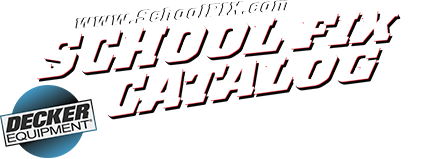

A top priority for any facility or school is the prevention of slips and falls and reducing the risk of injury to students, staff, and visitors. The best way to implement these preventive measures is to have a Floor Safety Plan. In order to create an effective Floor Safety Plan, risks will need to be identified and evaluated.
Reducing and eliminating slip and fall hazards will not happen overnight, but creating a comprehensive plan will provide actionable steps to achieve that goal. Below, we share our seven easy tips on how to prevent slips and falls by creating a maintainable floor safety plan for your school or facility.
#1 - Evaluate walking surfaces
The first step to creating a floor safety plan is establishing your building's floor types and conditions. This will help identify the risks of slips and falls. Surface evaluations should include outdoor walkways, such as sidewalks and parking lots, and indoor areas, including entryways, transition areas, gym floors, carpeted floors, and the condition and placement of matting. Note lighting and housekeeping efforts, as these can also contribute to potential accidents.
#2 - Keep walking surfaces decluttered and organized
Common issues include ice, wet floors, or wet or dry contaminants. Other considerations include uneven surfaces, wrinkled or loose carpets or matting, and cords or cables crossing flooring and walkways. Make a note of any other items protruding into walking areas. Straightening, fixing, and cleaning these areas will significantly improve floor safety and reduce the risk of slip and falls.
Protect students and staff from trip hazards by placing covers over power cords. Choose from durable indoor cord covers or choose the heavy-duty interlocking outdoor design. Perfect for any high-traffic areas that require a power source.
#3 - Repair surface imperfections and improve traction
Maintenance staff or contracted specialists can quickly repair uneven or cracked concrete, loose floor tiles, and buckling carpets. Removing these hazards and taking the time to make these repairs improves safety and can offset the cost of repairs down the road. If repairs cannot be done immediately, use temporary equipment such as cones, signs, and barriers to identify these problem areas, creating awareness and lowering the risk of an incident.
#4 - Minimize differences in transition areas
Transition areas, such as entrances, exits, or going from tile to carpet or wood to marble, create a greater risk of slips, trips, and falls because the walking surface changes. Matting and runners are often used in these areas to remove water, snow, or dirt; however, some matting can get oversaturated during inclement weather.
When this happens, the matting can shift, or corners can buckle, increasing the risk of falls. Make sure to use matting that's designed to absorb large amounts of water, with backing appropriate for the floor type, and will stay flat even during heavy traffic or bad weather.
Stop water and dirt at the door and keep all entrances safe, dry, and clean with heavy-duty entrance matting. Not sure which matting solution would work best for you? We recommend following the 3-Mat System →
1) Place scraper mats outdoors to scrape off large debris and moisture.
2) Place wiper/scraper mats indoors for further removal of debris and water.
3) Finally, place a wiper/finishing mat down as a final line of defense.
#5 - Contain leaks and prepare for spills
Use absorbents to capture liquid spills before these run into aisles or walkways. Place absorbent-type mats in areas that come into contact with moisture or contaminants regularly. This will ensure that dirt and water do not come into contact with flooring that's hazardous when wet or dirty.
A leaky roof can significantly increase the chance of a slip-and-fall accident. With the use of a Leak Grabber Kit, the water from the leak can be diverted and keep your floors dry. Electric Air Movers can also assist by keeping floors and matting dry. These industrial air blowers are useful in entranceways to keep air circulating and constantly dry wet floors and mats. They are also used for circulating air over freshly waxed or mopped floors. Air movers are portable and can be moved anywhere that wet and slippery floors pose a risk.
#6 - Bring attention to possible hazards
Entryway signs, cones, and barricades can help people be more aware of problem areas and pay more attention while walking. These solutions should only be used temporarily and should be removed once repairs, maintenance, or cleaning are complete, and walking surfaces are safe.
When documented, all the steps listed above can be used to create a comprehensive Floor Safety Plan. Establishing processes and procedures to mitigate risks will help reduce costly slip, trip, and fall injuries, plus keep students, staff, and visitors safe.
#7 - Ensure that regular maintenance and cleaning procedures are in place
Dirty floors can contribute to slip and fall injuries. Procedures to maintain floors properly should include cleaning frequency, correct cleaner types for different floor types, measuring cleaners correctly, verifying correct water temperature for cleaner type and floor type, and using clean tools and water. Store tools and equipment near each area as needed for easy accessibility during certain situations or times of the year.
Let School Fix® Help!
Many different slip, trip, and fall prevention products can be implemented into your facility’s plan, but if you’re on a tight budget and need anti-slip and safety solutions that are affordable, dependable, and easy to install, look no further than School Fix®. We hope you found this guide helpful. To read more about our products or solutions to common school maintenance concerns, please visit the School Fix® Blog.





